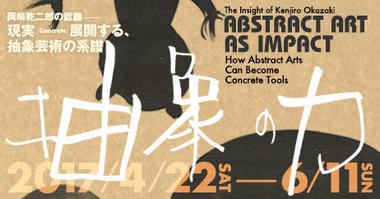 3:09 2018/03/23
3:09 2018/03/23
Aside from his active career as an artist, Kenjiro Okazaki (1955- ) has
continuously engaged in reinterpreting ossified art history and presenting
innovative views on works based on a broad knowledge of culture and art.
The intensity of these thrilling readings has often shaken up our minds.
Over the 20 years since its opening in 1995, Toyota Municipal Museum of
Art has been building up a singular collection. In order to reconsider the
richness of our collection and explore its unseen potentials, we are
organizing an exhibition curated by Kenjiro Okazaki. Focusing on art works
produced in between the First and the Second World War, and connecting
the missing links within our collection using works borrowed from other
institutions, this exhibition will examine the primal intensions of Abstract Art.
─
Abstract Art as Impact
─How Abstract Arts can become Concrete Tools
Kenjiro Okazaki
What lay at the core of artistic development since
Cubism was Materialism --the idea that matter bypasses
perception and works directly upon the mind.
This concreteness and directness of matter was what
Abstract Art pursued. The most important tool of the
avant-garde is this concrete power of Abstract Art.
However, after the Second World War, the essence of
Abstract Art became distorted and forgotten. There are
several reasons for this turn of events. The first is the
misinterpretation that Abstract Art was merely a visual
pursuit (as demonstrated by American Abstract
Expressionism); the second is the biased view which sees
Abstract Art as a matter of stylistic design (as claimed by
Taro Okamoto); and the third is the misuse of the term
"Concrete" (as shown by the Gutai group). These
erroneous views have together impeded the reasonable
understanding of how Abstract Art before the war actually
developed. Consequently, the activities of Japanese artists
who were interconnected with movements in other parts of
the world have been greatly misunderstood.
This exhibition aims to cut open this obscuring veil that still
covers the art world today, and re-discover the potentials
of avant-garde inherent in the Abstract Arts. The works of
Kazuo Sakata, Ryusei Kichida, Koshiro Onchi, Tomoyoshi
Murayama, Jiro Yoshihara, Saburo Hasegawa, or Ei-Q, will
be understood for the first time in connection to their
contemporary avant-garde artists such as Picabia,
Duchamp, Doesburg, Morandi, Sophie Taeuber-Arp, Jean
Arp, or Edward Wadsworth. This exhibition will finally
dissipate the obscurity of post-war art history and reveal
the true potential of Abstract Art that is all the more
significant in today's world.
─
Kenjiro Okazaki (b. 1955) is a Japanese visual artist whose
works span over several genres, including painting, sculpture,
as well as landscape design and architecture. Many of his works
has been featured in public collections throughout Japan and in
various exhibitions around the world. In 2002, Okazaki
participated in the Venice Biennale as the director of the
Japanese pavilion of the International Architecture Exhibition.
His works include a collaborative performance I Love my Robots
with the choreographer Trisha Brown, premiered in early 2007.
He received Smithsonian Artist Research Fellowship at
Hirshhorn Museum and Sculpture Garden (HMSG) in 2014.
Okazaki is also extremely active as a theoretician and critic,
and is the author or co-author of several books, including
Renaissance: Condition of Experience (Bunshun Gakugei
Library), featuring his analysis of Filippo Brunelleschi.
─
■Closed: Mondays (except May 1)
■Opening Hours: 10:00-17:30 (entrance until 17:00)
■Admission Fees: Adults ¥800 (700)
*High school and university students ¥500 (400)
*Free for elementary and junior high school students,
high school student (live in Toyota City), senior (75 and over)
and mentally or physically disabled people with one attendant.
*Bracketed figures represent the fees
for groups of 20 or more.
■Organized by Toyota Municipal Museum of Art
■Curated by: Kenjiro Okazaki (Artist)
Official website:http://www.museum.toyota.aichi.jp/exhibition/2017/special/okazaki.html
 3:09 2018/03/23
3:09 2018/03/23